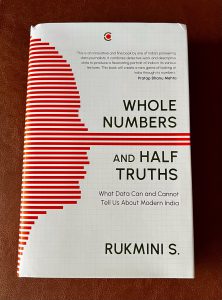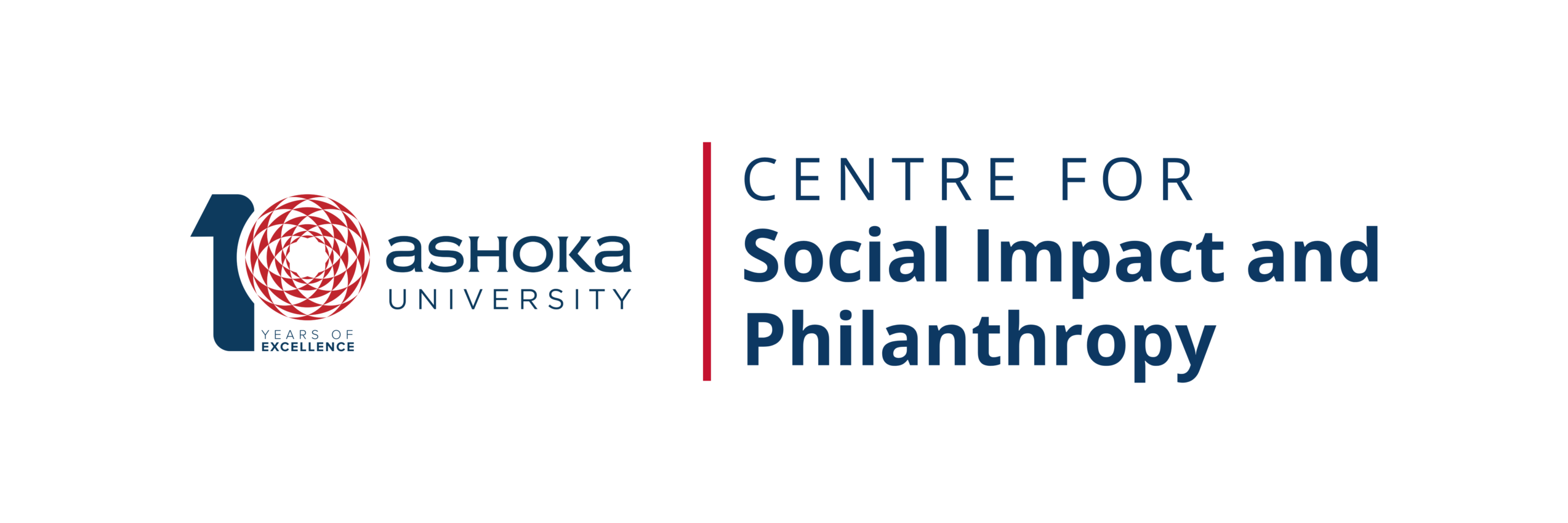


Whole Numbers and Half Truths by Rukmini S
A Nonprofit Perspective
Whole Numbers and Half Truths by the pioneering data journalist, Rukmini S, captures quite brilliantly the reali

 ty of India as revealed by the data that exist about how Indians live, work, marry, eat, vote, love and play. In so doing, she challenges misconceptions about, and throws up new insights into, our perceptions of ourselves as a people. Who in India is middle-class? What really prevents more Indian women from taking up paid employment? How do we feel about fellow citizens who practice religions different from our own or about crossing boundaries of caste? Are we predominantly vegetarian in our dietary habits? What drives our voting behaviour? Just as importantly, she illuminates the dark shadows where data either do not exist, are inaccessible or, increasingly, are obfuscated and suppressed.
ty of India as revealed by the data that exist about how Indians live, work, marry, eat, vote, love and play. In so doing, she challenges misconceptions about, and throws up new insights into, our perceptions of ourselves as a people. Who in India is middle-class? What really prevents more Indian women from taking up paid employment? How do we feel about fellow citizens who practice religions different from our own or about crossing boundaries of caste? Are we predominantly vegetarian in our dietary habits? What drives our voting behaviour? Just as importantly, she illuminates the dark shadows where data either do not exist, are inaccessible or, increasingly, are obfuscated and suppressed.
Absent data hampers policy-making and our capacity to evaluate policy. Deliberate fudging of data discredits all data rendering us incapable of finding common ground in a shared, fact-based reality. “Conversation,” Rukmini says, “has broken down between Indians Left and Right, and in the right hands, data can be that bridge. With investment, upgradation, commitment and independent oversight, India’s official statistical systems and public spirited private organisations can produce the data that gives us a fair idea of how India works and how most Indians are leading their lives. Ideological adversaries can still argue about the best way forward from there, but let the data bring us onto the same page first.”
Nowhere is this more apparent than in the data on civil society in India. Despite being the most stringently regulated and monitored sector, where every organisation must comply with onerous reporting requirements to multiple authorities or face dire consequences, data on the size, composition, growth, activities and impact of the sector are scant. It was only in response to United Nations reporting requirements and Supreme Court demands that the Ministry of Statistics and Programme Implementation (MOSPI) compiled some data in 2011. These statistics have since been oft-quoted, misquoted and extrapolated to discredit the sector. “There are 3.1 million NGOs in India,” one line of criticism avers, “more NGOs per capita than police persons.” The imputation is that we have too many NGOs and, possibly, that they are ineffective, legitimising cutting down their numbers and scope. Such cherry-picking of facts, fails to point out that the estimated number includes a vast array of organisations, from schools and hospitals to trade associations and community groups, even long defunct organisations. Quoting such data without reference to any benchmarks, the fact that India has half as many NGOs per capita than the USA, for instance, compounds the negative impact.
There are no good reasons why India’s nonprofits cannot be enumerated or have their economic impact measured. We routinely do this with other sectors including those much larger, much smaller and much less critical to the nation’s well-being. That the sector is subsumed under the “household” sector in the national accounts speaks either of the lack of interest in its activities or to some less charitable intent. A similar situation prevails with respect to philanthropy. All that the official data permit us to know is the number of individuals and organisations that claimed tax deductions against donations to charitable causes and the aggregate value of those claims. Despite ever more stringent scrutiny of tax returns and huge strides in digitising tax filing, even the most rudimentary data on this part of India’s philanthropy remains inaccessible. Over the past few years, taxes on the wealthy have been eliminated and tax rates lowered even as incentives for philanthropy have been whittled away. Without access to the data, no rational evaluation of these policy decisions has been feasible. In an era when, we are told, these funds are desperately needed to help meet our development goals, this is a particularly gross lacuna.
It’s patently obvious that India’s nonprofits helped save millions of lives and livelihoods during the COVID-19 pandemic. From supplying food to families reduced to penury overnight by the world’s most draconian lockdown enforced at only a few hours notice, to oxygen, medication and protective gear to health workers, hospitals, frontline workers and citizens scrambling for help, it was nonprofits and our fellow citizens who came to our rescue when we were utterly abandoned by our government. Many governments around the world recognised the critical value of the nonprofit sector in mitigating the effect of the pandemic and its role in rebuilding lives in its aftermath. As a consequence, they provided nonprofits with financial support, schemes to protect jobs and increased tax incentives. This was true even in countries like Russia and China, not particularly renowned for their support to civil society. Our government provided no such support. In contrast, India’s nonprofits were confronted with new, more onerous regulations during the pandemic and, in addition, found themselves having to compete for funding with the Prime Ministers Citizen Assistance and Relief in Emergency Situations (PM CARES) Fund. This fund, we now know, mopped up Rs. 14,067 crores or USD 1.88 billion in philanthropic resources from its inception in early 2020 until March 31, 2021 . While nonprofits’ pleas for relief were roundly ignored, government bodies like the NITI Aayog added to their reporting burden by demanding detailed reports of the scope and scale of NGOs’ COVID relief work. Compiled, these could paint a picture of the role the sector played during the crisis. Disappointingly, there has been no word from NITI Aayog on this front. Instead, the array of civil society advisory groups set up by them in August 2020, has just been dissolved. Like the number of Indians who perished from COVID, the number of migrant workers who lost their lives trying to get home to their families, and the number of patients who died for lack of oxygen we will likely never know how much India’s nonprofits did to save lives in the most hostile conditions.
India has a history and heritage of building great institutions, systems and processes that have generated the data that have permitted us all to understand our immense, diverse country. From the decadal census to national surveys on health, employment and a range of other topics, sterling work on a mammoth scale has gone into designing, implementing and reporting on India and Indians. Eroding those institutions as we have witnessed most recently in our management of data relating to the COVID-19 pandemic, has dire consequences. In Rukmini’s words, “Critics of the government have often framed the problems with Indian Covid data in the language of fraud and deceit; the government, in their telling, hid or made up numbers. The truth, however, lies in a combination of five cardinal sins in India’s data infrastructure, failings that leave their mark on most official statistics: not collecting essential data, not collating or publishing existing data in useable ways, obfuscating or suppressing some data, overselling data well beyond what it really says and knee-jerk criticism of inconvenient data. Some of these are institutional failings and we can hope that future governments turn things around for the next pandemic. But some of these are all-new and the alarm bells are ringing loud and clear for the future of India’s data integrity.”
Even before the pandemic, Indians had become fearful of State motives in collecting data thanks to the threat that the proposed National Population Register and the National Register of Citizens could be deployed to render millions stateless. These have potentially rendered any and all data collection exercises by the State or by private actors suspicious, especially to our most vulnerable citizens, and potentially disincentivised their participation, with terrible consequences to completeness and accuracy of all future surveys.
In Rukmini’s words: “For over 75 years,” she continues, “this data has shaped policy and driven change. It has given rise to passionate debates about growth, development and the trade-offs between them, about the trajectories that different Indian states have set off on, about which government schemes really reach the people and which ones remain on paper, and about how people’s most intimate thoughts and beliefs are changing. These conversations have helped us decide — or at the very least, argue about — who we want to be as a nation and how we want to get there. Think about the debate about liberalisation, economic reforms, redistributive policies, the poverty line, the welfare state, affirmative action, custom, rising Islamophobia — all of these fundamentally Indian debates are anchored in data collected by the state. Access to this data has empowered ordinary citizens to engage with and agitate against the state; public spirited economists and activists have taken this data from the pages of government reports to the streets. Data has been transformational for India. We need to build a future with more and better data that’s more widely available and easier to understand. Without it, we are in danger of hollowing out democracy.”
Readers who fear that a book about data might be too academic, technical or plain boring for the lay reader will be pleasantly surprised by its simple, lucid, non-polemical style and the manner in which the author brings the data to life through the stories of everyday people she has encountered in her travels across the country.
Do read it to widen and sharpen your understanding of India and Indians and to learn why we need more data of better quality that is more accessible to us as citizens.


